MaryAnn Bernal's Blog, page 42
October 14, 2017
Revealed: how the Georgians taught us to diet 300 years ago
History Extra
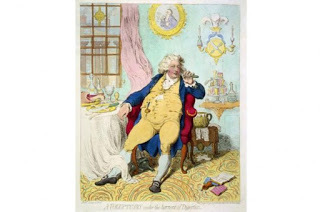
It’s that time of year again, when we vow to ditch the sugar, take out a gym membership, and follow religiously the latest weight loss guides. But while you might assume dieting to be a modern phenomenon, new research suggests it originates in an earlier century.
As early as the 18th century, diet doctors began to recommend strict, low fat meals, and newspapers featured adverts for tonic and diet pills.
Research carried out by Dr Corinna Wagner from the University of Exeter reveals how the perceived decadence of the Georgian period gave way to a more moderate and austere approach adopted by the Victorians.
In her new book, Pathological Bodies, Wagner demonstrates that by the mid-Victorian period, fighting fat had become a pastime for a large part of the population. Attitudes towards over-indulgence, obesity and body shape were hotly debated, and there developed a pressure to demonstrate self-restraint.
A greater emphasis was placed on the value of self-discipline – to be fat was to be immoral, irresponsible, and out of control.
Wagner told History Extra: “We associate the Georgians with being pleasure-seeking, and enjoying a lot of booze. Gout was almost a badge of honour – a sign you could eat and relax; that you had a ‘lust for life’.
“But a turning point came when a certain Scottish physician named George Cheyne decided to go on a diet. This was something people just did not do at the time.
“He cut out alcohol and even meat, and lost a huge amount of weight (from 32 stone to a ‘normal’ size). He published news of his weight loss success in a 1740 book called The Natural Method of Cureing [sic] the Diseases of the Body, and the Disorders of the Mind.
“He saw an opportunity to make money, so snapped up wealthy clients and showed them how to lose weight. He was, in effect, the first modern diet doctor.
“Due largely to his influence, there emerged a fashion for ‘diet doctors’ among the well-to-do.
“Newspapers started featuring adverts for tonic and even diet pills, and suddenly weight loss became fashionable.”
Wagner told History Extra that this change in attitude resulted from medical advances and political turmoil.
“An emphasis on health emerged at the same time as the radicalisation of the working class and the French Revolution across the channel.
“Diet was linked with Britain’s role as a world force – people began to worry about whether Britain could maintain its empire and global power.
“It was a time of social anxiety, and in response, people pointed to individuals and said ‘you are part of the problem’.”
This attitude was also used to political ends, Wagner explained. For example, King George IV’s extravagant lifestyle led to vitriolic public condemnation. His obesity became the focus of press and public ridicule.
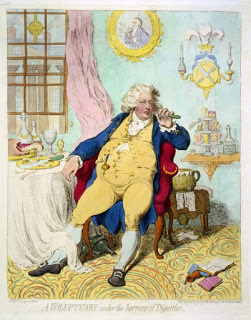
His weight was seen as a sign of his unfitness to rule, and politicians agitated for a transfer of power from the monarchy to government,” said Wagner.
“George IV was known to consume Persian and French delicacies, and his political enemies exploited that to incredible ends. It inspired an emphasis on British food such as roast beef and beer.
“George IV was used as a cautionary tale to eat local food. There developed the idea that you should be supporting your local community, and that it was bad to be dependent on foreign countries such as China or India.
“By the Victorian era, there were important medical advances in the area of obesity – and along with it, an emphasis in seeing into the body. Anatomy and dissection showed us the body’s physiology and functions.
“As a result, Victorian diet doctors like Thomas King Chambers, author of a book entitled Corpulence, prescribed strict regimens such as sea-biscuit for breakfast, and boiled macaroni and a piece of lean meat for dinner.
“There was also an interest in reading the body and face, and linking physical appearance to personal values. The Victorians were keenly interested in the idea that external features were linked to internal emotions, personality and intelligence.
“As today, demonstrating bodily self management was central to demonstrating status and social position, as well as values like self-respect and responsibility.
“Today, for example, being fat and on benefits is seen to indicate that you are selfish and irresponsible. Partially, we owe that perception to the Victorians.
“In Victorian society, individuals felt a pressure to demonstrate that they were not just consuming, but contributing. It’s amazing how that remains the same today.
“Then, as now, a fat body was a sign of a failing nation and community.”
Published on October 14, 2017 00:00
October 13, 2017
Archaeologist Claims that King Arthur Was Not a Real Person But a Fictional “Celtic Superhero”
Ancient Origins

A British archaeologist has controversially claimed that King Arthur was not a real historical figure. Rather, the legendary warrior king was created as a “Celtic superhero” and in reality, was nothing more than an amalgamation of the lives of five real-life warlords.
King Arthur a Creation of Several Real-life Kings?
Most people have heard tales of the legendary British monarch who rose to the throne by pulling his sword Excalibur out of a stone and ruled Britain with the help of the Knights of the Round Table and the wizard Merlin. As The Times report, however, archaeologist Miles Russell claims that he has solid evidence which proves that King Arthur never existed and was only created as a "Celtic Superhero.”
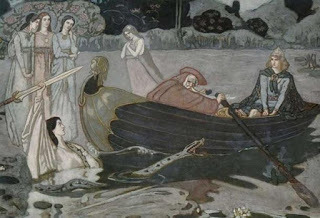
The taking of Excalibur by John Duncan ( Public Domain )
Traditionally, Arthur is believed to have led the British when they defeated an invading Saxon army at the legendary Battle of Badon sometime between 490 and 520AD. However, archaeologist and senior lecturer at Bournemouth University, Miles Russell, strongly believes that the greatest warrior king in British history, is basically a fictional creation of five real-life warlords. “When you start to look at King Arthur in detail you realize that he is an amalgam of at least five separate characters — he never existed as an independent person at all,” Dr. Russell tells The Times.
Glastonbury Monks Create Legends?
This is not the first time a respected scholar has claimed that Arthur was a fictional character. As previously reported by Liz Leafloor for Ancient Origins, the epic legends of King Arthur and his Round Table, among other ancient myths, may have been nothing more than fictional stories made up and peddled by enterprising monks at Glastonbury Abbey to make some money. What’s more, these legends muddied modern research into the site by “clouding the judgement” of past experts.
These, at least, were the claims made by a team of archaeologists from the University of Reading in 2015, after a conducting a four-year study. The physical history of the site was reexamined during the study and the conclusions were the following:
“Those feet, immortalized in William Blake’s poem Jerusalem, never walked on the green and pleasant land of Glastonbury; the oldest church in England was not built there by Christ’s disciples; Joseph of Arimathea’s walking stick does not miraculously flower every Christmas after 2,000 years. And it turns out that the supposed link with King Arthur and his beautiful queen, Guinevere, is false too – invented by 12th-century monks faced with a financial crisis in the wake of a disastrous fire.”
Archaeologists went on claiming that the Glastonbury monks clouded the history of the site by deliberately designing renovations after a fire in 1184. The redesign was said to have employed a purposeful archaic architectural style to generate a mythical feel, supporting popular legends and thereby raising more money from eager pilgrims. In addition, Arthur’s supposed grave has been revealed as a cemetery pit containing material dating from between the 11th and 15th centuries, offering no evidential links to the era of the legendary 5th and 6th century leader.
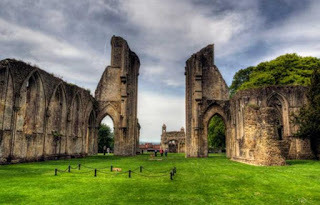
Glastonbury Abbey where King Arthur’s body was said to have been interred (Neil Howard / flickr)
The Role of Monmouth’s Book “A History of the Kings of Britain” to Arthur’s Legend
Dr. Russell explains that he came to his conclusion after studying “A History of the Kings of Britain,” written by Geoffrey of Monmouth in 1136, and other medieval texts. “Geoffrey’s book itself derives from a series of myths, stories and bardic praise poems that go back to the first century BC, at a time just before Britain became part of the Roman Empire,” Russell stated in a press release.
Initially, Dr. Russell noticed the obvious similarities between Arthur and Ambrosius Aurelianus, a leader of the Roman-British population in the fifth century. In the most contemporary account of the period, when Arthur was thought to exist, a British monk Gildas writing around 540AD in a scathing attack on the native Britons, names Ambrosius as the leader who leads the fight against the Saxon. What’s even more suspicious is that Gildas does not mention Arthur at all.
Other than Ambrosius Aurelianus, Dr. Russell cites Roman general Magnus Maximus, Byzantine Emperor Constantine the Great, and prehistoric warlords Arvirargus and Cassivellaunus as clear sources of inspiration for the creation of Arthur’s fictional character, “Once you take all these elements of his story away, there’s actually nothing left for Arthur,” Russell said as Bournemouth University’s official website reports. And added, “He’s an echo of all these other individuals – what Geoffrey of Monmouth did was create a Celtic superhero for his times, a character for the Britons to celebrate, taken from all the best bits of those individuals who lived before."
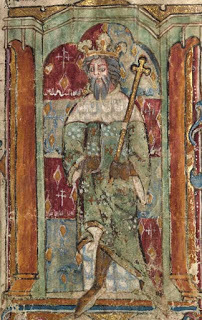
Magnus Maximus, one of the historical figures that Miles Russell believes was used to shape the character of King Arthur (Wikimedia Commons)
Dr. Russell presented his findings at the BBC History Magazine Conference at the Great Hall in Winchester on Saturday 7 October, while his book Arthur and the Kings of Britain: the historical truth behind the myths is out now, published by Amberley.
Top image: King Arthur. Detail. Charles Ernest Butler, 1903. (Public Domain)
By Theodoros Karasavvas
Published on October 13, 2017 00:00
October 12, 2017
Metal Detectorist’s Roman Hoard Linked to a Temple that Likely Inspired The Lord of the Rings
Ancient Origins
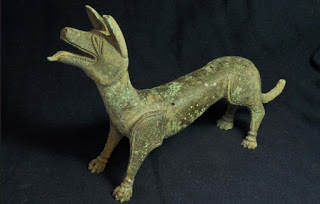
Metal Detectorist’s Roman Hoard Linked to a Temple that Likely Inspired The Lord of the Rings
Two metal detecting enthusiasts made a “once in a lifetime” discovery when they unearthed a hoard of Roman bronze artifacts at an undisclosed location. The most exciting of the finds is an intact healing statue that has been linked to the Roman Lydney Temple. This is the same temple that inspired JRR Tolkien to add a key element to The Hobbit and The Lord of the Rings.
The Licking Dog Hoard
The Guardian reports that the 4th century bronze hoard was discovered by Pete Cresswell and Andrew Boughton in Gloucestershire. Archaeologist Kurt Adams, the Gloucestershire and Avon finds liaison officer, calls the finely detailed healing statue of a standing dog “a unique find for British archaeology.” It is the only known sculpture of a licking dog dating to Roman times to be found in Britain.
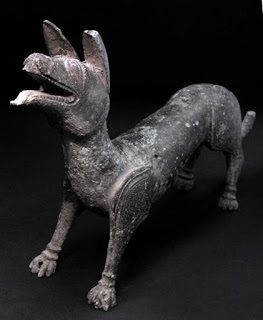
The Roman ‘licking dog’ healing statue. (Eve Andreski/Portable Antiquities Scheme/CC BY 2.0)
Speaking on the find, Mr. Cresswell said:
“It’s not every day you come across a hoard of Roman bronze. We have been metal detecting for a combined 40 years, but this is a once in a lifetime discovery. As soon as I realized the items were of historical significance I contacted the local archaeology team, who were equally excited by the find. It’s a great privilege to be able to contribute to local and British history.”
Apart from the dog figurine with its tongue out, the other bronze pieces appear to have been deliberately broken and hidden. Archaeologists believe that the hoard was tucked away by a metal worker who probably wanted to melt and recast the bronze.
Romans in Gloucestershire
The licking dog statue has been found in a region that was a strong and important part of Roman Britain. Gloucester (Roman Nervia Glevensium or, less formally, Glevum) was probably founded by the Romans around AD 90-98 and was of the highest order of Roman towns, denoted coloniae. These were either completely new settlements or based on a previously established fort. The latter is the case for Gloucester, which was built on the site of a fort which was used as a post for the expansion of the Empire into Wales. The area was then allotted to the veterans of Legio II Augusta, according to the Association for Roman Archaeology (ARA). The town would then have been predominantly, if not exclusively, populated by Romans. After the removal of the military in AD 407, the town began to decline and would eventually be lost to the Anglo-Saxons in the sub-Roman period around the 5th and 6th centuries AD.
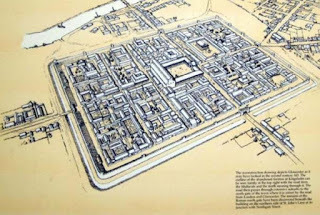
Visualization of 2nd century Gloucester by Philip Moss (Gloucestershire Archaeology)
The Romans were in this area (and Britain generally) for over half a millennium. The area surrounding Glevum became heavily Romanized, with Roman towns (eg. Glevum, Corinium), many villas (some of which have been excavated such as Chedworth and Woodchester), forts and temples. One such temple found in the area is at Lydney Park Roman Camp, 20 miles (32 km) along the River Severn estuary. It is here we reconnect with the bronze dog statue.
Lydney Camp and Lydney Temple
The site of Lydney Camp was originally an Iron Age hillfort which was for a time mined by the Romans for iron ore around the 3rd century. In the 4th century, they built a Romano-Celtic temple dedicated to the Celtic deity Nodens, which is known due to inscriptions of the name found at the site.
The Celtic god, Nodens, is associated with healing, the sea, hunting and dogs – mainly due to representations of all of these aspects being found at the temple complex. The temple is thought to have been primarily dedicated to healing and includes a bath house. Nine dog statues or effigies have been found there, the most famous being the “Lydney Dog” Bronze. This dog iconography is representative of healing, as dogs were once kept in order to lick wounds and aid healing.
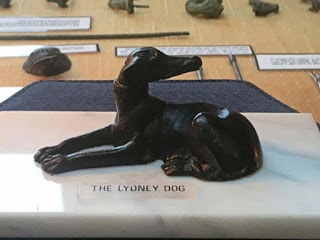
The Lydney dog was one among many dog themed artifacts found at the Lydney Temple or Temple of Nodens (Credit: ARA)
The reason the new licking dog bronze has been tentatively linked with this temple, is that it is the only healing temple known in the area. However, the statue could be indicative that there is a hitherto unknown healing temple or shrine to be found in the vicinity.
Tolkien at Lydney Temple
A point of interest worth mentioning whilst on the subject of Lydney Temple is the believed influence it had on that world-renowned fantasy-fiction about a ring quest by JRR Tolkien. In 1928-9, the author was invited to Lydney Park by the eminent archaeologists Sir Mortimer Wheeler and his wife Tessa, who had been commissioned to investigate the site. At the time, Tolkien was invited in his capacity as Professor of Anglo-Saxon at the University of Oxford in order to explore the origins of the name ‘Nodens’, as there was little record of this god other than at the Temple complex. According to historian and author Matthew Lyons, Tolkien’s article “is an extraordinary testament to his skill and erudition.”
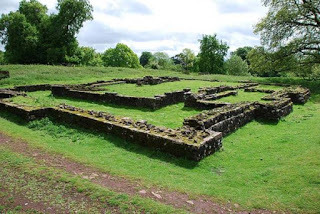
Ruins of the Temple of Nodens at Lydney Park (Jeff Collins CC BY-SA 2.0)
Tolkien visited this place several times, staying in the rather splendid house and one imagines enjoying the grounds of the country manor. Besides the old local name for the location of the temple at what is now Camp Hill being ‘Dwarfs Hill’, it being riddled with tunnels from the mining and whispers of small people and goblins and the like in the area, Lyons sites two specific items related to the Temple that are thought to have brought about the ring element to the story.
The first item is a curse tablet that is from the temple. It reads as follows:
“To the God Nodens. Silvanus has lost a ring. He has [vowed] half its value to Nodens. Amongst all who bear the name of Senicianus, refuse thou to grant health to exist, until he bring back the ring to the Temple of Nodens.”
The curse invokes the support of Nodens to help Silvanus regain a ring that has somehow been lost to Senicianus. And so the second item comes in the form of the actual ring referred to, which is believed found in a church/farmers field in Silchester half way across the country! It is denoted as most likely the ring of the curse, as Senicianus had a fresh inscription of, ‘‘Seniciane vivas in deo” (Senicianus, may you live in God).
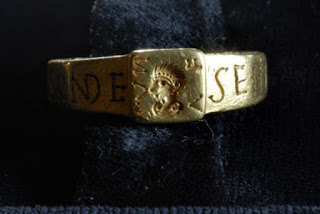
The Roman ring with Senicianus inscription (Credit: The Vyne © National Trust / Helen Sanderson)
It is interesting that the curse demands the ring should be returned to the place from whence it came (the Temple of Nodens). Although there is a leap from a ring with a curse attached to a ring of power such as appears in Tolkien’s epic, and there are other rings found in legends, such as those found in the Arthurian legends, Lyons argues that the ring story at Lydney, “may have simply caught his imagination and been buried away somewhere in his unconscious.” If so, it wasn’t buried for long, as in 1932, just a few years after his visits to Lydney Temple, The Hobbit, with its mysterious ring theme was finished.
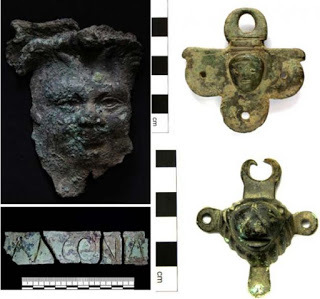
Some of the broken artifacts found in the Roman bronze hoard. (Eve Andreski/Portable Antiquities Scheme/CC BY 2.0)
The location of the recent Roman hoard find has not yet been publicized so the connection to Lydney Temple is currently sheer speculation. The hoard is currently being kept under controlled conditions at Bristol Museum whilst being photographed and recorded. Once analysis is completed, the findings will be presented at the British Museum. Experts expect to have a report ready by the end of this year.
Top Image: The recently unearthed ‘licking dog’ statue. (Gloucestershire County Council)
By Gary Manners
Published on October 12, 2017 01:00
October 11, 2017
True Path of Hadrian's Wall Excavated in Newcastle
Ancient Origins
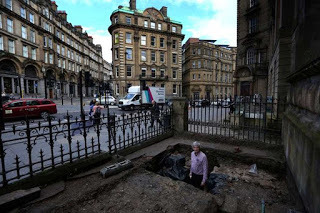
A previously recorded stretch of Hadrian's Wall has been rediscovered in Newcastle in northeastern England. Researchers made the discovery as they excavated land during restoration works at a Victorian building.
Part of Hadrian’s Wall Unearthed in the Heart of Newcastle
The section of the historic wall was uncovered outside the Mining Institute on Westgate Road and experts now suggest that the discovery will shed new light on its route across the north of England according to a report in Chronicle Live. Archaeologists working on a project to restore a building in the city's center unearthed the section, which was last seen during 1952 construction on the same site. However, Simon Brooks, acting general manager of the Mining Institute, doesn’t appear so sure about the initial discovery that took place in the 1950’s, “There was some controversy about whether the Wall had been found, he tells Metro. And continues, “A lot of people were skeptical but now we have proof positive and we are delighted,” pointing out with confidence that the new discovery leaves no doubt whatsoever.
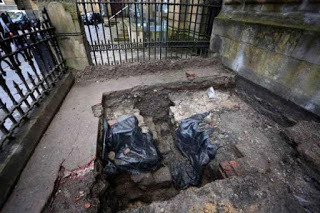
The lost section of Hadrian’s Wall that has been uncovered in Newcastle, UK (Image: NCJ Media)
The Marvelous Wall of Hadrian
Built by Emperor Hadrian of the Roman Empire, Hadrian's Wall stretches across the width of England south of its modern border with Scotland. As Ivan Petricevic reported for Ancient Origins in 2014, this remarkable monument covers over seventy miles (120 km) going from Wallsend on the east coast of England in North Tyneside to the salt marshes of the Solway Estuary in Cumbria on the west coast. It was built in two phases under the direction of Roman Emperor Hadrian, who was among the ‘Five Good Emperors’ of Rome. Hadrian was an extremely prominent Roman Emperor, who reigned from 117 to 138 AD.

Hadrian’s wall crosses the north of England, south of the border with Scotland, from Newcastle upon Tyne in the east to Carlisle in the west (Image: Left, CC BY SA 3.0 Right, CC BY-SA 3.0)
According to historical records, Hadrian was a very generous man, giving large amounts of money to communities and individuals, and is said to have been one of the few emperors that wanted to live unassumingly, like a private citizen. Hadrian was also well known for his extensive traveling throughout his empire, and it was Hadrian who laid the foundations of the Byzantine Empire.
Hadrian's building projects are without a doubt his most enduring legacy. He founded cities throughout the entire Balkan Peninsula, Greece, Egypt and even Asia. The Arch of Hadrian constructed by the citizens of Athens in 132 AD honor Hadrian as the founder of the city. He also re-built the Pantheon and constructed the Temple of Venus and Roma. But his most important monument is the wall constructed in the north of England.
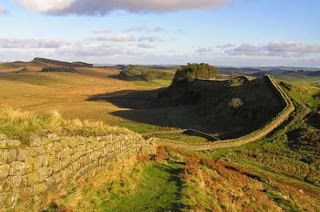
The view along Hadrian's Wall towards Housesteads Roman Fort. (CC BY-NC 2.0)
Known in the past as Vallum Hadriani, the construction process of the wall began around 122 AD, corresponding to the visit of the Roman emperor to the province. Originally 3 m wide (10 ft) and up to 6 m (20 ft) in height east of the river Irthing, and 6 m (10 ft) wide and 3.5 m (11.5 ft) meters high west of the river, the wall stretches over a vast distance across uneven terrain. It is believed that the wall was originally covered in plaster and was white-washed, giving the wall a shining surface that would have reflected the sunlight and making it visible from many miles away.
The construction project took six years to complete and was first thought to have been built by slaves, but this was later disproven. It is now known that the builders of Hadrian's Wall were Roman legionaries who were stationed in Britain in over a dozen fortifications located along the wall. Hadrian's Wall underwent a series of mayor repairs standing strong as the northwestern frontier until the fall of the Roman Empire in the 5th century AD. The first excavations of Hadrian's wall are believed to have been undertaken by William Camden in the 1600's but the first actual drawings of the wall were made in the 18th century with formal archaeological studies beginning in the 19th century and continuing until today.
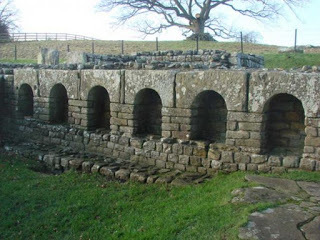
The Bath House, Chesters Fort, Hadrian's Wall. (CC BY-SA 2.0)
Further Investigations Also Uncover Foundations of Westmoreland House
Fast forward to 2017, the recent excavation works have also uncovered the foundations of Westmoreland House, which was destroyed to make space for the Mining Institute building in Neville Hall, which opened in 1872.
As Metro reports, the house was property of the wealthy Neville family and dates back to the 14th century. A dig inside the institute has unearthed a cellar of Westmoreland House, which had been substituted with slag in order to upsurge the ground after the building’s destruction. Animal bones, oyster shells and clay pipes were also found to be mixed with the slag. “It looks like they are using whatever they could get their hands on to fill in the cellars,” archaeologist Alan Rushworth told Metro.
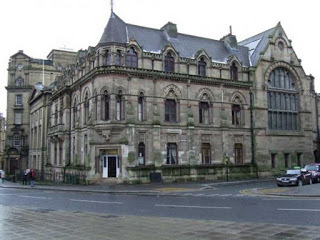
The North of England Institute of Mining and Mechanical Engineers (Thomas Nugent CC BY-SA 2.0)
Further investigations at the site are now continued by The Archaeological Practice. Archaeologists suggest that more sections of the wall are believed to occupy space underneath Newcastle, while the remains of a small Roman fort have also been found nearby.
Top image: Simon Brooks showing the section of Hadrian's Wall that's been found on Westgate Road outside the Mining Institute (Image: Newcastle Chronicle)
By Theodoros Karasavvas
Published on October 11, 2017 00:30
October 10, 2017
Huge Hoard of Ancient Roman Silver Coins Worth £200,000 Found During Treasure Hunt
Ancient Origins
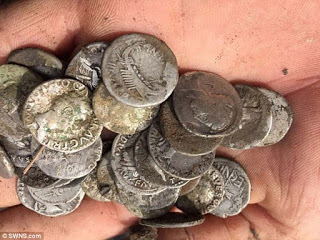
Fisherman and amateur historian Mike Smale, was hunting for treasure with friends from the Southern Detectorists club when he found a hoard of ancient silver Roman coins potentially worth £200,000. Experts suggest that the discovery is very important as it will shed light on the history of Roman Britain.
Unexpected Discovery of Roman Treasure T
he amateur treasure hunter and historian saw his dreams come true by using a simple metal detector. The 600 Roman Denarii were discovered in a field in Bridport, where Mike Smale and friends from the Southern Detectorists club were hunting in hope to find something big. The treasure “hunting” was organized by Sean MacDonald, who as hoping to witness the discovery of an important treasure. All of a sudden, Smale’s detector started beeping insistently, moments before Smale would discover the first of what turn out to be a huge quantity of coins. "It was incredible, a true once-in-a-lifetime find,” Smale said as The Herald reports.

Mike Smale (left) detected the coins on farmland managed by Anthony Butler (right) (Image: SWNS)
Wasting no time, Smale called over the officials, who sectioned off the area, “I had a good idea about what it was. I had already found one or two Roman denarii that morning. When I dug a hole I saw two coins sticking out the bottom of it, so I called Sean over to have a look at it,” the man said as The Herald reports. “It's a great find, my biggest one, but I shan't be giving it up. It's great fun and I'm sticking with it,” Smale added.
Additionally, an ecstatic MacDonald, couldn’t believe that he had finally witnessed the discovery of a massive hoard, "Bridport is a cracking area anyway, it's very rich in history, but a find like this is unprecedented. I've never seen a hoard of this size before. We found one in Somerset last year but there were just 180, and they weren't of the same caliber. I was elated and shaking because this is a once in a lifetime find,” he stated at the The Herald reports.
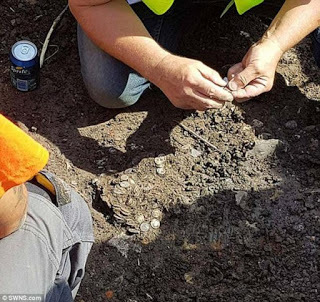
The stash of over 600 coins were found during an organised metal detector hunt in Bridport, Dorset, UK (Image: SWNS)
Certain Objects Date Back to Mark Antony and Cleopatra’s Era
Some of the metal disks were minted during the era Roman general Mark Antony was allied with Cleopatra in Egypt and experts now suggest that an archaeological discovery of this size and variety is extremely rare. "The archaeologists excavating it couldn't believe what they were seeing because these coins are so rare. I personally think a find of this size and variety will never be found again," MacDonald told The Herald.
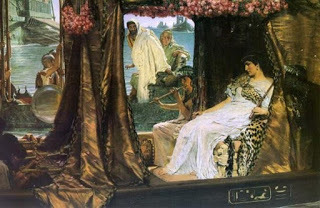
The Meeting of Antony and Cleopatra by Lawrence Alma Tadema (Public Domain)
Numismatist and coin expert Dominic Chorney, said after examining photos of the coins that some of them depict Gods, and were issued by the Roman Republic a few centuries before the birth of Jesus Christ. In a long and detailed statement, Mr. Chorney explains as The Herald reports,
"Others, which feature a distinctive galley - a type of Roman vessel - were minted by Mark Antony while he was allied with his lover Cleopatra in Egypt, between the Autumn of 32 BC to the Spring of 31. They each celebrate the various legions under his command. Antony's coins circulated widely in the Roman Empire, and have certainly traveled a long way.
Republican coins and those of Antony were issued before the Roman Invasion of Britain in AD 43, and would have drifted over in the pockets of Roman soldiers and citizens alike. Others were issued by emperors who ruled during the first century AD. One I can see in the photograph was struck for the ill-fated emperor Otho, who only ruled for three months in (January to April AD 69), during the civil wars which followed the assassination of the notorious emperor Nero.”
Ultimately, Mr. Chorney didn’t forget to mention that the discovery of these coins could possibly reveal new information about Roman Britain’s history, "Coin finds such as this are fascinating, and are incredibly important in shedding light on the history of Roman Britain," he said as the The Herald reports. The coins will be handed over to the coroner for valuation and then likely sold to a museum, with the profits split between the farmer and Smale.
Top image: A handful of the rare Roman coins that were part of the hoard (Credit: SWNS)
By Theodoros Karasavvas

Fisherman and amateur historian Mike Smale, was hunting for treasure with friends from the Southern Detectorists club when he found a hoard of ancient silver Roman coins potentially worth £200,000. Experts suggest that the discovery is very important as it will shed light on the history of Roman Britain.
Unexpected Discovery of Roman Treasure T
he amateur treasure hunter and historian saw his dreams come true by using a simple metal detector. The 600 Roman Denarii were discovered in a field in Bridport, where Mike Smale and friends from the Southern Detectorists club were hunting in hope to find something big. The treasure “hunting” was organized by Sean MacDonald, who as hoping to witness the discovery of an important treasure. All of a sudden, Smale’s detector started beeping insistently, moments before Smale would discover the first of what turn out to be a huge quantity of coins. "It was incredible, a true once-in-a-lifetime find,” Smale said as The Herald reports.

Mike Smale (left) detected the coins on farmland managed by Anthony Butler (right) (Image: SWNS)
Wasting no time, Smale called over the officials, who sectioned off the area, “I had a good idea about what it was. I had already found one or two Roman denarii that morning. When I dug a hole I saw two coins sticking out the bottom of it, so I called Sean over to have a look at it,” the man said as The Herald reports. “It's a great find, my biggest one, but I shan't be giving it up. It's great fun and I'm sticking with it,” Smale added.
Additionally, an ecstatic MacDonald, couldn’t believe that he had finally witnessed the discovery of a massive hoard, "Bridport is a cracking area anyway, it's very rich in history, but a find like this is unprecedented. I've never seen a hoard of this size before. We found one in Somerset last year but there were just 180, and they weren't of the same caliber. I was elated and shaking because this is a once in a lifetime find,” he stated at the The Herald reports.

The stash of over 600 coins were found during an organised metal detector hunt in Bridport, Dorset, UK (Image: SWNS)
Certain Objects Date Back to Mark Antony and Cleopatra’s Era
Some of the metal disks were minted during the era Roman general Mark Antony was allied with Cleopatra in Egypt and experts now suggest that an archaeological discovery of this size and variety is extremely rare. "The archaeologists excavating it couldn't believe what they were seeing because these coins are so rare. I personally think a find of this size and variety will never be found again," MacDonald told The Herald.

The Meeting of Antony and Cleopatra by Lawrence Alma Tadema (Public Domain)
Numismatist and coin expert Dominic Chorney, said after examining photos of the coins that some of them depict Gods, and were issued by the Roman Republic a few centuries before the birth of Jesus Christ. In a long and detailed statement, Mr. Chorney explains as The Herald reports,
"Others, which feature a distinctive galley - a type of Roman vessel - were minted by Mark Antony while he was allied with his lover Cleopatra in Egypt, between the Autumn of 32 BC to the Spring of 31. They each celebrate the various legions under his command. Antony's coins circulated widely in the Roman Empire, and have certainly traveled a long way.
Republican coins and those of Antony were issued before the Roman Invasion of Britain in AD 43, and would have drifted over in the pockets of Roman soldiers and citizens alike. Others were issued by emperors who ruled during the first century AD. One I can see in the photograph was struck for the ill-fated emperor Otho, who only ruled for three months in (January to April AD 69), during the civil wars which followed the assassination of the notorious emperor Nero.”
Ultimately, Mr. Chorney didn’t forget to mention that the discovery of these coins could possibly reveal new information about Roman Britain’s history, "Coin finds such as this are fascinating, and are incredibly important in shedding light on the history of Roman Britain," he said as the The Herald reports. The coins will be handed over to the coroner for valuation and then likely sold to a museum, with the profits split between the farmer and Smale.
Top image: A handful of the rare Roman coins that were part of the hoard (Credit: SWNS)
By Theodoros Karasavvas
Published on October 10, 2017 00:30
October 9, 2017
New release from author K. Meador - Abigail - Kindle edition now available

Abigail meets an unlikely friend on a day when nothing seems to be going right.
Ages 4-8
Amazon Link
Meet the Author

Author Page
I'm just a simple girl who loves simple things: * Enjoying my children * Living in the country * Driving my tractor (farming - my idea of heaven on earth) * Having fun with family and friends * Reading, writing, photography, swimming, bbq, and margaritas. I hope my stories will put a smile on your face and joy into your hearts.
Bringing Stories Alive, One Word at a Time,
Published on October 09, 2017 00:00
October 8, 2017
9 strange facts about the history of apples
History Extra
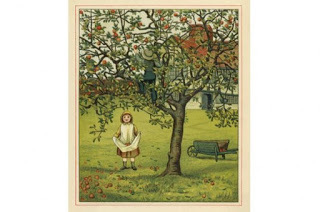
1) The apple originated in the so called 'fruit forest' of Eastern Europe The fruit would have been smaller and more bitter than the apples we eat today. Travellers through the forest would have eaten the larger, sweeter apples, and started the process of selection, spreading pips across Europe and north into the Baltic regions.
2) In the Christian tradition the apple is associated with Eve's disobedience, right? Wrong She ate the fruit of the tree of the knowledge of good and evil, and so God expelled Adam and Eve from the Garden of Eden. But the fruit is not described as an apple in any of the texts – the apple was put into the story by artists.
3) Apples don't grow true from a pip – each apple pip grows up into a unique tree The only way to get exactly the same apple is to graft a piece of apple wood onto a piece of rootstock. The ancient Egyptians knew how to do this, as did the Ancient Greeks and Romans. The Celts were also aware of how to cultivate apples, so sweet apples existed in Britain before the Romans arrived.
4) Royalty have always loved apples Henry VII paid huge sums for individual apples, and Henry VIII had an orchard in Kent with many different varieties, and he imported French gardeners to look after them. Meanwhile, Catherine the Great loved Golden Pippin apples so much she had them brought over to her palace in Russia, each one wrapped in real silver paper.
Queen Victoria was also a fan – she particularly liked baked apples. A canny Victorian nurseryman called Lane named a variety 'Lane's Prince Albert.' This apple is still in cultivation.
5) Apples are a linked to fairyland It’s said that if you fall asleep in an orchard you may wake up years later, while treasure buried under an apple tree will allegedly never rot or be found. It's no coincidence that we go apple bobbing at Halloween: both the water and the fruit will put you in touch with the fairy kingdom. One Halloween tradition involves taking a bite from an apple and then sleeping with it under your pillow in order to dream of your true love.
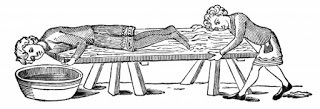
6) Cooked apples were served as a street food An 18th-century Italian traveller, Caraciolli, complained that the only ripe fruit he ate in Britain was a baked apple. A form of roasted, semi-dried apple – the Norfolk Biffin – is mentioned by Charles Dickens as a Christmas delicacy: the Victorians ate a lot more fruit and vegetables than we might think.
7) Apples were sold from barrows and baskets in the streets of the big cities by costermongers This old-fashioned word for greengrocer comes from 'costard', which was a large variety of apple. Lord Shaftesbury, Victorian campaigner for children's rights, once disguised himself as a costermonger, complete with a barrow of fruit and veg, to experience the working conditions for himself.
8) The Victorian era saw a huge increase in the number of apple varieties being grown Many of these were bred by gardeners on large estates, and although they put the work in – grafting the scion onto the rootstock – the apples were named after their employers. Examples of such named varieties still extant include Lady Henniker and Lord Burleigh.
9) The Victorians studied apples In 1854 the British Pomological Association was formed to test new varieties of fruit to establish their suitability for British growers. Its secretary, Robert Hogg, had set out his knowledge of fruit in his British Pomology, in 1851. Hogg’s opening sentence shows how important the apple had become to all aspects of culture and cultivation: “There is no fruit, in temperate climes, so universally esteemed and so extensively cultivated, nor is there any which is so closely identified with the social habits of the human species, as the apple”.
Joanna is a food historian studying at the University of Essex. She is halfway through a PhD on the social and cultural history of the apple and the orchard. Joanna is also one of the founders of the Trumpington Community Orchard Project, a local community orchard – it was this project that inspired her apple research, or 'pomology'. When she is not studying Victorian texts, or weeding the orchard, she works in a local garden centre and gives talks on how to look after apple trees.
Published on October 08, 2017 00:30
October 6, 2017
L.A. Punk Snapshots by Brenda Perlin - Kindle color edition now available
L.A. Punk Snapshots in Color: Before they became huge international stars, Billy Idol, The Clash, Iggy Pop, The Damned, Bad Religion, T.S.O.L., and many other acts played the L.A. circuit.

L. A. Punk Snapshots gives readers a window into the world of punk rock and its fans during the 1980s in Los Angeles. As the fledgling punk scene unfolded, sixteen-year-old Brenda Perlin was there to capture history with her camera. Before they became huge international stars, Billy Idol, The Clash, Iggy Pop, The Damned, Bad Religion, T.S.O.L., and many other acts played the L.A. circuit; and Perlin was there behind the scenes. Truly paradoxical, young, naïve Perlin infiltrated the punk world, and the result is a collection of photographs that is sure to please any music fan.
Amazon Link

L. A. Punk Snapshots gives readers a window into the world of punk rock and its fans during the 1980s in Los Angeles. As the fledgling punk scene unfolded, sixteen-year-old Brenda Perlin was there to capture history with her camera. Before they became huge international stars, Billy Idol, The Clash, Iggy Pop, The Damned, Bad Religion, T.S.O.L., and many other acts played the L.A. circuit; and Perlin was there behind the scenes. Truly paradoxical, young, naïve Perlin infiltrated the punk world, and the result is a collection of photographs that is sure to please any music fan.
Amazon Link
Published on October 06, 2017 23:30
Journeys to the Underworld – From Ancient Greece to Holywood
Ancient Origins
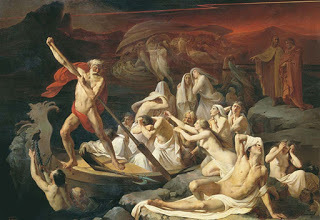
Paul Salmond /The Conversation
The success of Patty Jenkins’s Wonder Woman, depicting warring Olympians and Amazons, continues to stoke moviegoer interest in Greek mythology. Wonder Woman is the first foray of D.C. movies into classical mythology, a path well trodden by the Marvel cinematic universe. But is Greek myth simply a favoured and enduring wellspring for heroic sagas full of supermen and monsters or are there deeper forces at play?
To the Greeks, the underworld journey was an ideal vehicle for the hero to display his exceptional qualities, often involving the rescue of a soul trapped there. A central convention of Greek mythological narratives is katabasis, the hero’s journey to the underworld or land of the dead. At Circe’s urging, Odysseus consults the seer Tiresias in the land of the dead, where many departed souls (including Achilles) appear to him. Similar journeys are made by Heracles who rescues Theseus during his twelfth labor; Hermes, who rescues Persephone from Hades; and Aeneas who is reunited briefly with his dead father.
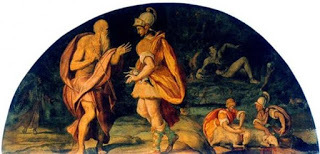
Alessandro Allori (1580) Odysseus questions the seer Tiresias. (Public Domain)
Descents into and ascents from the underworld are themes incorporated repeatedly into modern cinema. Film developed from theatre, which in its earliest form was a way of animating mythical sagas. The katabasis has endured in cinema because it can be applied to most characters, times and settings. Often eschewing a literal journey to the underworld, a cinematic katabasis may follow a quest into a type of hell, whether a physical or psychological space.

Christian Gottlieb Kratzenstein Orpheus and Eurydice, 1806. (Public Domain)
One particularly celebrated underworld myth recounts Orpheus’s retrieval of his wife Eurydice. Against the warnings of Hades and Persephone, Orpheus looked back at her - only for his wife to disappear, this time permanently. Roman Polanski’s Chinatown (1974), drew directly on this myth by sending its hero, like Orpheus, into the realm of the dead to retrieve an imperilled soul trapped there.
Polanski and screenwriter Robert Towne created a bleak vision of 1938 Los Angeles, parched by drought and corrupted by a shadowy cabal of oligarchs. Private investigator Jake Gittes, investigating the death of city water commissioner Hollis Mulwray, uncovers a web of corruption and murder. His attempts to rescue Mulwray’s wife, Evelyn, from the violence enveloping her results in her brutal death. In its shocking conclusion, Polanski rooted Chinatown more firmly in its mythological ancestry, pivoting the plot towards an incest revelation. Like Oedipus, redress comes through putting out eyes. Having failed to save his former love years before, Jake grieves over her death a second time with Evelyn.
Chinatown is broadly accepted as a response to Watergate. Like many films of its time, it responded to Nixon’s subversion of US political institutions by depicting a world where shadowy underworld denizens win and the hero fails to rescue his Eurydice from Hades.
In this response, Chinatown demonstrates how the influence of Greek mythological conventions on American filmmakers appears strongest during times of heightened political stress. When many perceived America as attacked from within by communism during the 1950s, for instance, Hollywood responded by reimagining Homer’s perfect warrior Achilles through the towering figure of John Wayne (through no coincidence, the most virulently anti-communist actor of all). In John Ford’s The Searchers (1956), Wayne’s embittered Confederate veteran Ethan Edwards mutilates the body of Comanche war chief Scar to avenge Ethan’s defiled nieces. Like Achilles mutilating Hector in Homer’s Iliad, Ethan hates his enemies beyond death.
In the 1970s, a younger cadre of filmmakers and audiences saw the enemy sitting in seats of power. Underworld quests found more subversive avenues for expression, like Francis Ford Coppola’s Apocalypse Now (1979), which conveyed the horrors of the Vietnam war through a nightmarish journey up the river Styx.
Underworld narratives also formed part of Hollywood’s response to widespread moral panic around ritual abuse and child murder that spread throughout America in the 1980s and 1990s. The horrific sprees of society’s new apex predators like Ted Bundy and John Wayne Gacy, linked to hysterical rumours of organised child sacrifice, inspired a film cycle fuelled by pervasive anxiety that children could be snatched up and borne away to horrible fates in hidden lairs. When Jonathan Demme’s The Silence of the Lambs swept the 1992 Oscars it was our neighbours or the corner grocer - not the government - preying on our fears.
Demme’s film deftly refashioned the myth of Theseus and the minotaur into a race-against-time manhunt. Cadet FBI agent Clarice Starling pursues a serial murderer who has abducted a Senator’s daughter. To track the beast, Clarice must descend into the den of captured cannibal monster Hannibal Lecter for clues to slay the monster at large, Buffalo Bill. For this underworld quest, Lecter is the pedagogue, not the monster. His role isn’t to eat Clarice (he passes up that opportunity when she ventures within striking distance) but to prepare her for her journey. Lecter provides the ball of string enabling Clarice to venture into the minotaur’s labyrinth and return.
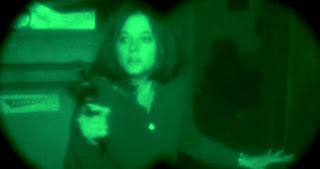
Jody Foster as Clarice Stirling in The Silence of the Lambs.
Why does American cinema reflect Ancient Greek narrative conventions most strongly at times of profound social anxiety? The answer may lie in part in political similarities between Americans and ancient Athenians and the perceived vulnerability of their constitutional foundations.
Traditionalists interpret Greek art as an expression of soaring confidence in the triumph of humans over the old gods. But the Athenians were obsessed by the ephemerality of their achievement and how it rested on foundations that could collapse at any time. The late critic Robert Hughes once asserted that “ancient Greek sculpture is used to advance a specious political argument” of man being the measure of all things. Yet Greek art, he argued, was just as focused on warding off monsters (representing political threats).
Ancient mythological themes are employed most unmistakably in American movies during times of “witch hunts” to expose hidden enemies: communist saboteurs in the 1950s, corrupt political burghers of the 1970s and the “satanic panic” of the 1980s. In response to 9/11, Hollywood was oddly reticent, as if the seismic scale of the event meant translating 9/11 to the screen was unimaginable. But television responded forcefully, particularly through the great HBO crime dramas - The Sopranos, The Wire, Deadwood - all of which at various times employed underworld sagas in confronting the scarring and resounding effects of violence.
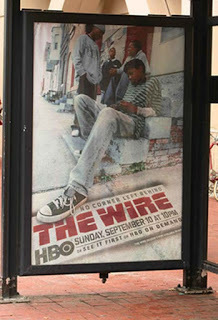
HBO's ‘The Wire’. Bus Stop Billboard Display. (Elvert Barnes/CC BY 2.0)
Ancient Myth and Cinema in a Time of Trump
What can we expect to see next as the rise of “Trumpism” promotes internal American division possibly unmatched since the civil war? Certainly, taking at face value Trump’s identified public enemy the “liberal media” (which includes filmmakers), US political institutions are under attack in a manner not seen since 1974. Like Nixon, Trump accuses his critics of witch hunts aimed at sabotaging the will of the people and uprooting American values.
We are yet to see reactions to the President reflected in cinema. Trump was elected ten months ago and has held office for only eight, so films responding to his Presidency are still in production. But the social trauma that saw the ascendancy of Trump’s base – the impoverishment of the “rust belt”, paranoia over Mexican gang culture, the erosion of the natural environment in the face of rapine corporations – are already part of the cinematic landscape.
And we are already seeing key political battlegrounds - the migration of drug crime across the southern border and the violation of the natural world at other frontiers - framed as underworld quests in film.
Director/screenwriter Taylor Sheridan recently explored issues of American decline in his unofficial “frontier trilogy”, using Greek mythological conventions to do so. The middle film, Hell or High Water (2016) is a relatively straightforward backwoods heist saga pitting bank-robbing brothers against a Texas ranger nearing retirement. The script reflects the financial angst of Trump voters, largely sympathising with their perceived disenfranchisement. But the first film, Sicario (2015) and the most recent, Wind River (2017) are dramatic bookends, using mythology to explore the social anxieties that saw Trump elected.

Poster for ‘Sicario’. (Public Domain)
Directed by Canadian Denis Villeneuve, Sicario depicts an idealistic FBI agent, Kate Macer, recruited by a government taskforce to combat drug cartels at the Mexican border. Overseen by a shadowy operative, Alejandro, Kate descends into a moral and literal abyss to track her quarry, eventually rejecting her handlers’ demands that she become a monster to fight monsters. In Wind River, the discovery of a young Arapaho woman’s body on a snowbound Wyoming reservation teams hunter Cory Lambert with another rookie FBI agent, Jane Banner, to track down her killer.
Wind River and Sicario are violent, electrifying films, which embrace Greek mythic conventions by sending their heroes to the realm of the dead both in pursuit of monsters and in embrace of loved ones.
In Sicario, Kate and Alejandro pursue the drug lord, Alarcon, across a Mexican landscape made hellish through darkness and night vision technology. Whereas Kate emerges from the underworld with her moral compass intact, Alejandro maddened by the murders of his wife and daughter now resides there permanently. As he tells Kate, “You will not survive here. You are not a wolf and this is a land of wolves now.”
In Wind River the murdered girl, Natalie, was a friend of Cory’s daughter - who had died in similar circumstances three years earlier. Like Orpheus, Cory experiences the loss of his beloved twice, heightening his corrosive need to have her back. But the land of the dead is not always hostile. In the film’s final scene, Cory and Natalie’s father Martin sit together in silence, mentally visiting their lost daughters in the spirit realm.
Both films are sprinkled with references to mythological deathscapes: frozen Wyoming mountains and darkened Mexican foothills become landscapes of dread. Cory, like the hero Heracles, is a hunter of lions; and wolves, traditional guardians of dead souls, embody links between living and dead.
Greek mythological conventions will likely again be used to critique what many see as a uniquely lawless US administration. It will pay to watch the output of Joss Whedon, for one, whose The Avengers (2012) depicted an Homeric world where spectacular battle scenes framed an exploration of the transformative effect of violence, the weight of heroic expectations and the toll both take on men and women who deal in warfare.
Few directors working today are as familiar with Greek heroic archetypes as Whedon. In his signature television production, Buffy the Vampire Slayer, Whedon reimagined the doomed Achilles as a teenage girl who at one point returned from a literal journey to the realm of the dead. Given Trump’s treatment of and standing with women, it will be interesting to see the nature of the heroine’s quest, and the monsters she encounters along the way, in Whedon’s upcoming project Batgirl.
We may not yet know what kinds of underworlds will need to be negotiated in years ahead. But American filmmakers are uniquely experienced in passing through landscapes of dread, emerging stronger and more enlightened.
Top Image: Alexander Dmitrievich Litovchenko (1835 - 1890) "Charon carries souls across the river Styx." Source: Public Domain
The article, originally titled ‘Friday essay: journeys to the underworld – Greek myth, film and American anxiety’ by Paul Salmond was originally published on The Conversation and has republished under a Creative Commons license.
Published on October 06, 2017 01:00
October 5, 2017
1,000-year-old Viking Sword in Extraordinary Condition Discovered in Ireland
Ancient Origins
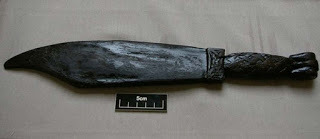
A 1,000-year-old wooden Viking weaver’s sword has been unearthed by archaeologists at the historic site of the former Beamish and Crawford brewery in Cork city, Ireland. Experts describe the sword as an artifact of “exceptional significance.”
Perfectly Preserved Viking Sword Discovered in Ireland
As The Irish Times report, the Viking sword was discovered in great condition, a fact that made archaeologists particularly happy. According to information available so far, the valuable finding is just over 30cm ()12 inches in length, made entirely from yew, and it features carved human faces typical of the Ringerike style of Viking art, dating back to the late 11th century. The Viking artifacts were discovered in May, but they were officially announced only recently, following an informal visit to the Cork Public Museum by the Norwegian Ambassador to Ireland, Else Berit Eikeland.
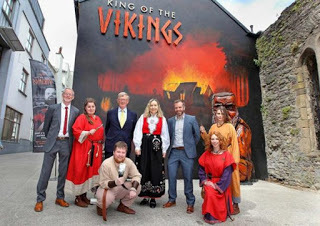
Else Berit Eikeland (center) at King of the Vikings Exhibit, Waterford, Ireland (Image: kingofthevikings)
Dr. Maurice Hurley, a consultant archaeologist and leader of the dig at the site, described the sword as one of a handful of artifacts of "exceptional significance" uncovered during recent excavation works at the South Main Street site. Also found were untouched ground plans of 19 Viking residences, relics of central hearths and bedding material. "For a long time there was a belief that the strongest Viking influence was on Dublin and Waterford, but the full spectrum of evidence shows that Cork was in the same cultural sphere and that its development was very similar," he said as The Irish Times reported. "A couple of objects similar to the weaver’s sword have been found in Wood Quay, but nothing of the quality of craftsmanship and preservation of this one," he added.
Else Berit Eikeland (center) at King of the Vikings Exhibit, Waterford, Ireland (Image: kingofthevikings) Dr. Maurice Hurley, a consultant archaeologist and leader of the dig at the site, described the sword as one of a handful of artifacts of "exceptional significance" uncovered during recent excavation works at the South Main Street site. Also found were untouched ground plans of 19 Viking residences, relics of central hearths and bedding material. "For a long time there was a belief that the strongest Viking influence was on Dublin and Waterford, but the full spectrum of evidence shows that Cork was in the same cultural sphere and that its development was very similar," he said as The Irish Times reported. "A couple of objects similar to the weaver’s sword have been found in Wood Quay, but nothing of the quality of craftsmanship and preservation of this one," he added. AD Entrepreneur Elevator Pitch Ep2: 'Has Anybody Not Seen That Product?' Sponsored by CONNATIX The hilt of the 30cm (12 inches) long Viking weaving tool (BAM Ireland) Dr. Hurley appeared pleasantly surprised about the fact that the several wooden items had survived underground in such a great condition. “It’s quite miraculous,” he said as The Irish Times report. Additionally, he suggests that the sword was used mainly by women for daily tasks, "The sword was used probably by women, to hammer threads into place on a loom; the pointed end is for picking up the threads for pattern-making,” he said. A Remarkable Sword Find Despite the immense archaeological and historical value of the recent discovery, this is not the first time such an old Viking sword has discovered. Last month, a hunting party found an incredibly well-preserved metal Viking sword laying openly in rocks high in the hills in Norway. The approximately 1100-year-old blade was rusty but otherwise in almost pristine condition due to the quality of the iron and the extreme cold conditions of where it was found. Hiker stumbles upon 1,200-year-old Viking sword while walking an ancient trail in Norway Hunters Find Striking Viking Sword Isolated at High Altitude in Norway The Viking sword, dated to c. AD 850-950. ( Espen Finstad, Secrets of the Ice/ Oppland County Council ) As April Holloway reported in a previous Ancient Origins article, a team of hunters tracking geese in Skaftárhreppur, South Iceland, discovered a 1,000-year-old Viking sword lying completely exposed in the sand almost a year ago. The double-edged sword was of extraordinary condition considering its age. The sword was then passed to The Cultural Heritage Agency of Iceland, which carried out further testing and preservation work on the sword. Sword of Late Viking Age Burial Unveiled Exhibiting Links Between Norway and England 1,000-Year-Old Viking Sword Discovered in Iceland by Men Hunting Geese 1,000-year-old sword found in Iceland Credit: Árni Björn Valdimarsson Such finds are rare but you are far more likely to come across a metal sword that is 1000 or more years old than a wooden one. That said, earlier this month Ancient Origins reported on two small, wooden, Roman era swords, aged at least 1600 years, that had been well-preserved sealed earth at Vindolanda, England. These are thought to be toy swords and the quality of handicraft does not match that of the new find. Two Roman Cavalry Swords and Two Toy Swords Amongst Treasures Found at Frontier Fort Researchers Wonder if Rich Viking Boat Burial Found in Scotland was Made for a Warrior Woman One of the ancient toy wooden swords, with a gemstone in its pommel ( The Vindolanda Trust ) Viking swords often had handles that were richly decorated with intricate designs in silver, copper, and bronze. The higher the status of the individual that yielded the sword, the more elaborate the grip. Dr. Hurley appears to agree with the general consensus as he said about the newly discovered sword, “It’s highly decorated - the Vikings decorated every utilitarian object," The Irish Times report. It is not just the marked difference in the workmanship which shows this to be a weaver’s sword, but also other items found in the vicinity, which include a wooden thread-winder carved with two horses’ heads, also associated with fabric weaving. The human head carved at the end of the hilt (Image: BAM Ireland) Lord Mayor of Cork Describes Holding the Sword as a “Magical” Experience An exuberant Tony Fitzgerald, Lord Mayor of Cork, described his experience holding a Viking sword that had been hidden for almost a millennium as something magical. “The moisture on the dagger was fresh; it was in perfect condition,” he said as The Irish Times reported, while he also made a bold prediction that there will be “a very strong public interest” when the items go on display, which could be as early as February 2018. Ultimately, the valuable Viking remains are currently undergoing post-excavation examination by conservationists at the National Museum of Ireland. Curator of Cork Public Museum Daniel Breen expressed his interest to direct an exhibition on the Viking influence in Cork, but he added that it’s way too soon for that, as the exposure of the artifacts to too much oxygen could be catastrophic for them without chemical treatment first. Top image: The Viking weaver’s sword found at the South Main Street dig in Cork (Image: BAM Ireland) By Theodoros Karasavvas Section: Artifacts Ancient Technology News History & Archaeology Tags: Viking sword weaver weaving Wood wooden ireland carved tool Ringerike You Might Also Like Elkhorn Student Stuns Doctors With Crazy Method to Melt Fat Is This “Healthy” Food Making You Bloated? Ten Real Life Giants You Won't Believe Actually Exist After Weeks Of Rumors, Joanna Gaines Comes Clean 1 Simple Trick Removes Eye Bags & Lip Lines in Seconds We Say Good Bye To Joanna And Chip ? THEODOROS Theodoros Karasavvas J D -M A has a cum laude degree in Law from the University of Athens a Masters Degree in Legal History from the University of Pisa and a First Certificate in English from Cambridge University When called... Read More Show Read the Comments RELATED ARTICLES ON ANCIENT-ORIGINS 24 SEPTEMBER, 2017 - 22:52 THEODOROS KARASAVVAS 1,000-year-old Viking Boat Burial Discovered Under Market Square in Norway A millennium-old Viking boat grave with bones and sheet bronze still inside has been discovered under a market square in Norway. The grave was found during one of the final days of excavations by the... READ MORE ABOUT 1,000-YEAR-OLD VIKING BOAT BURIAL DISCOVERED UNDER MARKET SQUARE IN NORWAY 24 SEPTEMBER, 2017 - 19:01 THEODOROS KARASAVVAS You Speak Like a Viking! 10 Everyday Words in English with Old Norse Origins Did you know that many words we use today such as “husband,” “happy,” and “egg” are of Old Norse origin? No? Well, this isn’t surprising, as in the minds of many people the Vikings were nothing but a... READ MORE ABOUT YOU SPEAK LIKE A VIKING! 10 EVERYDAY WORDS IN ENGLISH WITH OLD NORSE ORIGINS 9 SEPTEMBER, 2017 - 22:52 ALICIA MCDERMOTT Hunters Find Striking Viking Sword Isolated at High Altitude in Norway Four friends were slowly making their way across the high altitude rocky terrain while hunting reindeer in Oppland, Norway. One noticed a rusty object sticking out of the rocks. Curiosity took over... READ MORE ABOUT HUNTERS FIND STRIKING VIKING SWORD ISOLATED AT HIGH ALTITUDE IN NORWAY 8 SEPTEMBER, 2017 - 23:07 ALICIA MCDERMOTT First Genetic Proof of a Viking Age Warrior Woman is Identified from an Iconic Swedish Grave “Then the high-born lady saw them play the wounding game , she resolved on a hard course and flung off her cloak; she took a naked sword and fought for her kinsmen's lives , she was handy at fighting... READ MORE ABOUT FIRST GENETIC PROOF OF A VIKING AGE WARRIOR WOMAN IS IDENTIFIED FROM AN ICONIC SWEDISH GRAVE 14 AUGUST, 2017 - 23:02 ANCIENT-ORIGINS Even in Viking Times Norway was Famous for its ‘White Gold’… a ‘Gold’ You can Eat! New research using DNA from the fish bone remains of Viking-era meals reveals that north Norwegians have been transporting – and possibly trading – Arctic cod into mainland Europe for a millennium... READ MORE ABOUT EVEN IN VIKING TIMES NORWAY WAS FAMOUS FOR ITS ‘WHITE GOLD’… A ‘GOLD’ YOU CAN EAT! 14 AUGUST, 2017 - 14:00 THEODOROS KARASAVVAS Laser Tech Reveals 1,000-Year-Old Viking Ring Fortress in Denmark With the help of laser technology, archaeologists have managed to discover a perfectly circular ring fortress in Borgring, Denmark. It dates back to 975-980 AD, and experts suggest that it was... READ MORE ABOUT LASER TECH REVEALS 1,000-YEAR-OLD VIKING RING FORTRESS IN DENMARK Login AO – Login Premium Click here to REMOVE the ADS MOST READ TODAY Edgar Cayce, Six-fingered Giants and the Supernatural Creation Gods of Atlantis: Part 1 Edgar Cayce, Six-fingered Giants and the Supernatural Creation Gods of Atlantis: Part 2 1,000-year-old Viking Sword in Extraordinary Condition Discovered in Ireland Outstanding Reconstruction of Ancient Egypt in Next Assassin’s Creed Including Combat-Free Educational Mode Is the Universe Only 6,000 years old? Young Earth Creationists Say Yes! Gaius Marius was the Savior of Ancient Rome, but was he a Hero or Villain? Click here to REMOVE the ADS
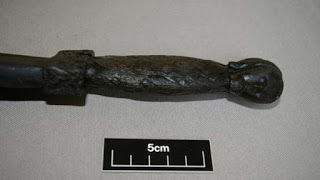
The hilt of the 30cm (12 inches) long Viking weaving tool (BAM Ireland)
Dr. Hurley appeared pleasantly surprised about the fact that the several wooden items had survived underground in such a great condition. “It’s quite miraculous,” he said as The Irish Times report. Additionally, he suggests that the sword was used mainly by women for daily tasks, "The sword was used probably by women, to hammer threads into place on a loom; the pointed end is for picking up the threads for pattern-making,” he said.
A Remarkable Sword Find
Despite the immense archaeological and historical value of the recent discovery, this is not the first time such an old Viking sword has discovered.
Last month, a hunting party found an incredibly well-preserved metal Viking sword laying openly in rocks high in the hills in Norway. The approximately 1100-year-old blade was rusty but otherwise in almost pristine condition due to the quality of the iron and the extreme cold conditions of where it was found.

The Viking sword, dated to c. AD 850-950. ( Espen Finstad, Secrets of the Ice/ Oppland County Council )
As April Holloway reported in a previous Ancient Origins article, a team of hunters tracking geese in Skaftárhreppur, South Iceland, discovered a 1,000-year-old Viking sword lying completely exposed in the sand almost a year ago. The double-edged sword was of extraordinary condition considering its age. The sword was then passed to The Cultural Heritage Agency of Iceland, which carried out further testing and preservation work on the sword.
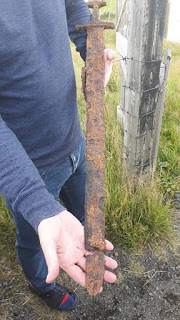
1,000-year-old sword found in Iceland Credit: Árni Björn Valdimarsson
Such finds are rare but you are far more likely to come across a metal sword that is 1000 or more years old than a wooden one. That said, earlier this month Ancient Origins reported on two small, wooden, Roman era swords, aged at least 1600 years, that had been well-preserved sealed earth at Vindolanda, England. These are thought to be toy swords and the quality of handicraft does not match that of the new find.
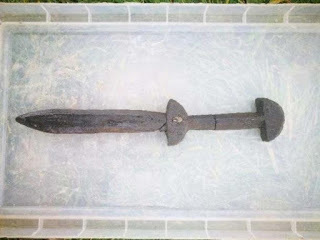
One of the ancient toy wooden swords, with a gemstone in its pommel ( The Vindolanda Trust )
Viking swords often had handles that were richly decorated with intricate designs in silver, copper, and bronze. The higher the status of the individual that yielded the sword, the more elaborate the grip. Dr. Hurley appears to agree with the general consensus as he said about the newly discovered sword, “It’s highly decorated - the Vikings decorated every utilitarian object," The Irish Times report.
It is not just the marked difference in the workmanship which shows this to be a weaver’s sword, but also other items found in the vicinity, which include a wooden thread-winder carved with two horses’ heads, also associated with fabric weaving.
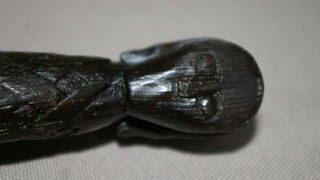
The human head carved at the end of the hilt (Image: BAM Ireland)
Lord Mayor of Cork Describes Holding the Sword as a “Magical” Experience
An exuberant Tony Fitzgerald, Lord Mayor of Cork, described his experience holding a Viking sword that had been hidden for almost a millennium as something magical. “The moisture on the dagger was fresh; it was in perfect condition,” he said as The Irish Times reported, while he also made a bold prediction that there will be “a very strong public interest” when the items go on display, which could be as early as February 2018.
Ultimately, the valuable Viking remains are currently undergoing post-excavation examination by conservationists at the National Museum of Ireland. Curator of Cork Public Museum Daniel Breen expressed his interest to direct an exhibition on the Viking influence in Cork, but he added that it’s way too soon for that, as the exposure of the artifacts to too much oxygen could be catastrophic for them without chemical treatment first.
Top image: The Viking weaver’s sword found at the South Main Street dig in Cork (Image: BAM Ireland)
By Theodoros Karasavvas
Published on October 05, 2017 00:30



